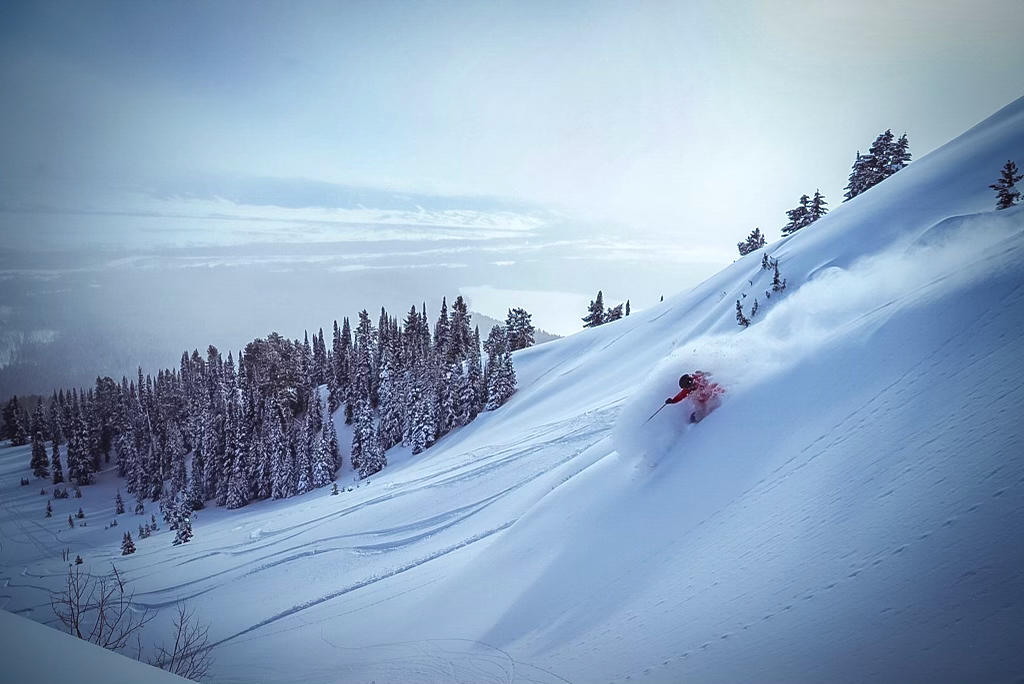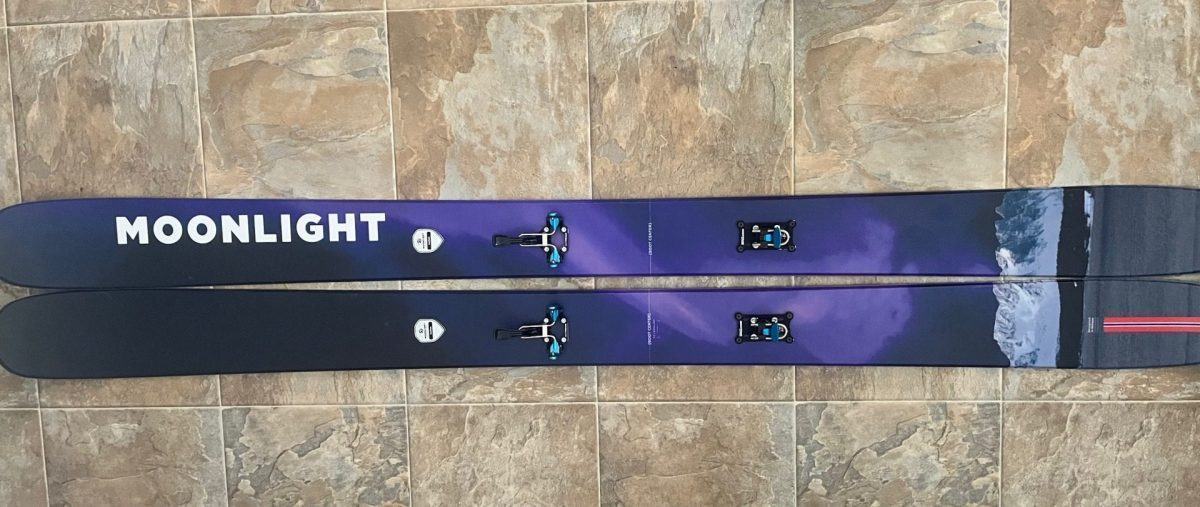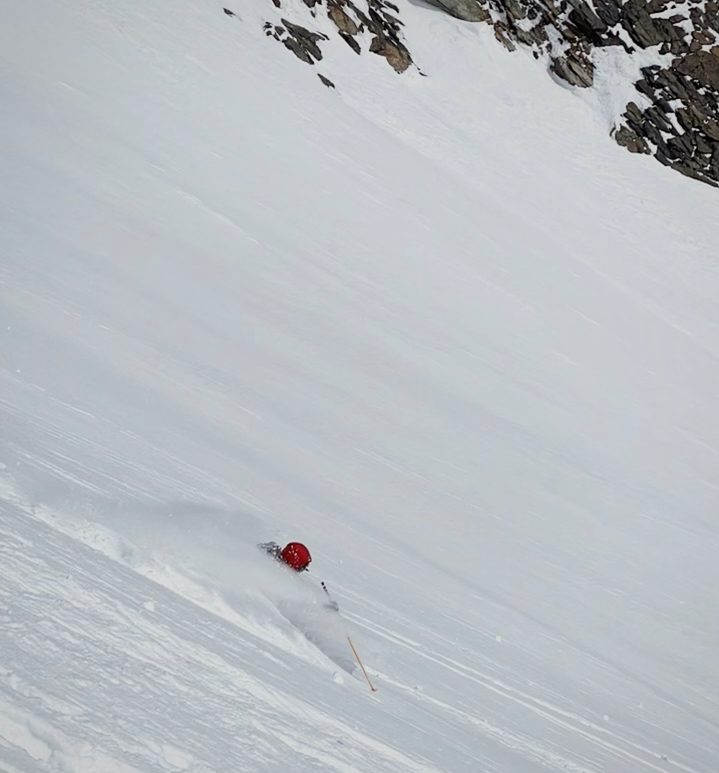Norway’s Moonlight Mountain Gear comes in big light at 120mm underfoot and a claimed weight of 1625g. As the powder dancing ensued last season in the Tetons, here were some thoughts: “When I think of the perfect slope for the Cruiser, it’s wide open, +/-30 degrees, with copious, untracked powder – for its weight, I don’t think there is a ski that would be more fun to open it up with on this dreamy slope.”
Cruiser 120 Product Overview
I first heard of Moonlight Mountain Gear three or four years ago in a ski news post about the “lightest skis in the world.” I remember checking them out – they had some extremely light racing and mountaineering skis but didn’t stand out as something I needed to get my hands on (or could afford). Fast forward to February 2021, perhaps the most memorable month of powder skiing I’ve been lucky enough to experience. I was constantly debating between my Blizzard Zero G 105s – lightweight but not so fun in deep powder, and a pair of Blizzard Spurs – sort of fun in powder but at an unworkable weight of close to 2400g/ski. After many days of backseat powder skiing or sore hip flexors that season, I began to wonder, can I have the best of both worlds? Something that is fun to ski in deep powder while also being light enough to manage on a big day of touring. The Moonlight Cruiser could be just the ticket.
First, a bit of justification for owning a ski this big (and light).
When I reflect on my favorite days in the mountains, many of these best memories involve copious powder on long days spent with great friends. Sure, there are some high peaks, and sunny corn runs in the memory bank, but there isn’t much that compares to the pure bliss of a (or, in this case, many) bottomless powder run. With that in mind, I have a specific pair of skis for firm or technical couloirs and a general “daily driver” ski, but for a while, not a ski that worked well in really deep powder. Sure, it’s fun to ski a narrower, less rockered ski in powder, but at a certain point, keeping the tips above the surface becomes the main focus of each turn. Now, think how fun the best powder days would be if you could pressure your tips, initiate a turn from the front of your boots, and surf along without any worries about tip dives or the ensuing somersaults: pure bliss. That, and taking advantage of those magical days, sun up to sun down, is why you might own a ski like this.
More on Moonlight Mountain Gear – they are a Norwegian company designing and crafting skis and headlamps in Northern Norway. Their ski line consists of six shapes, from a 65mm skimo race ski (the Arrow) to the Cruiser – a 120mm powder touring ski. Each shape is available in either a 100% carbon layup or a 50/50 Carbon/Fiberglass layup. The carbon layup models are the lightest skis for their size out there (for example, the Cruiser 120mm/186cm weighs in at 1300g), while the 50/50 skis are still among the lightest, but perhaps a bit less “out there” (e.g., 1625g for the same Cruiser 120mm ski). Aside from the astonishing weight figures, I’d generally categorize their line by long turn radii, long but subtle rocker lines, and fairly directional shapes with traditional (often -10cm or more) mount points.
For this review – I received a pair of the Cruiser 120mm skis in the 50/50 construction. They come in at 186cm and 1625g/ski. I mounted them with my favorite Ski Trab Gara Titan bindings for a super light, super floaty, powder touring machine. I’ve spent a bunch of time on a few skis in the 120mm+ category, namely the Blizzard Spur and 4FRNT Renegade – hopefully, this gives me the background I need to tell you more than “WOW! so much float!!”
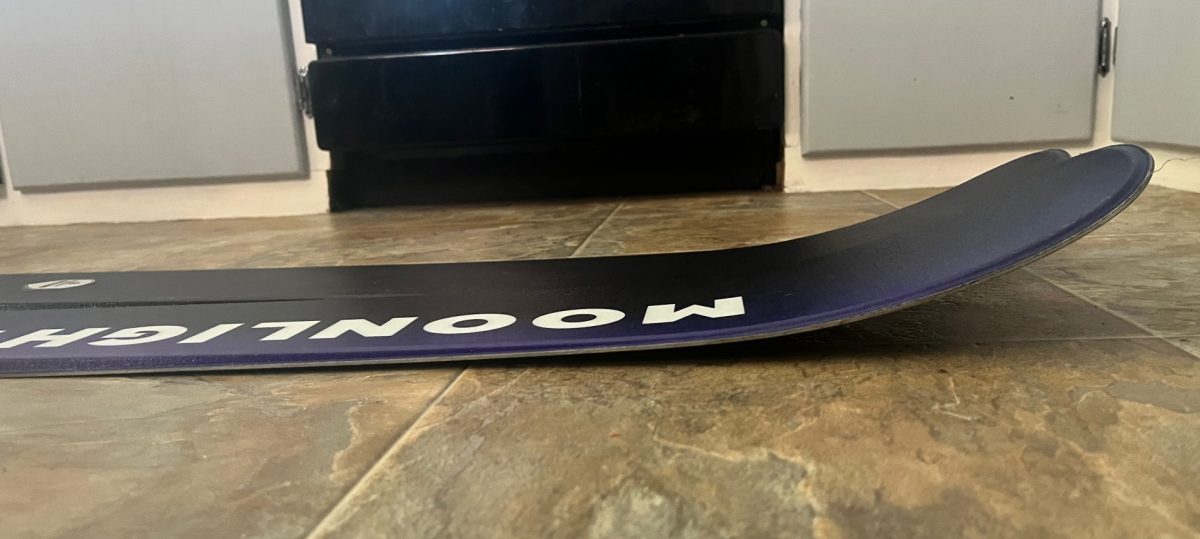
The rocker, sidecut, and taper are also quite subtle, with some resemblance to the old DPS Lotus 120 hybrid and less in common with some of the more radical powder ski shapes of recent years. The tip rocker is quite subtle- 55cm long; it rises less than 1 cm before the tip curve begins.
Moonlight Cruiser 120 50/50 CFG Metrics
Available lengths (cm): 177, 186
Dimensions (mm): 139-114-129 (177), 145-120-135 (186)
Radius (m): 26
Mass (g): Claimed: 1625g
Mount Position (cm from center): -11 cm
Construction Highlights: Cap Construction; 50% Carbon, 50% Fiberglass; Proprietary Fjaercore
Shape: Long radius, moderate tip/tail taper, slight pintail
Profile: Deep, subtle tip rocker line
Binding & Boot Pairing Tested: Mounted with Ski Trab Gara Titan. Tested with Technica Zero G Tour Pro (323mm BSL) and Scarpa Alien RS (218mm BSL)
Similar Models: DPS Lotus 120 Hybrid, Scott Scrapper 115, Head Kore 117
MSRP: $897.94
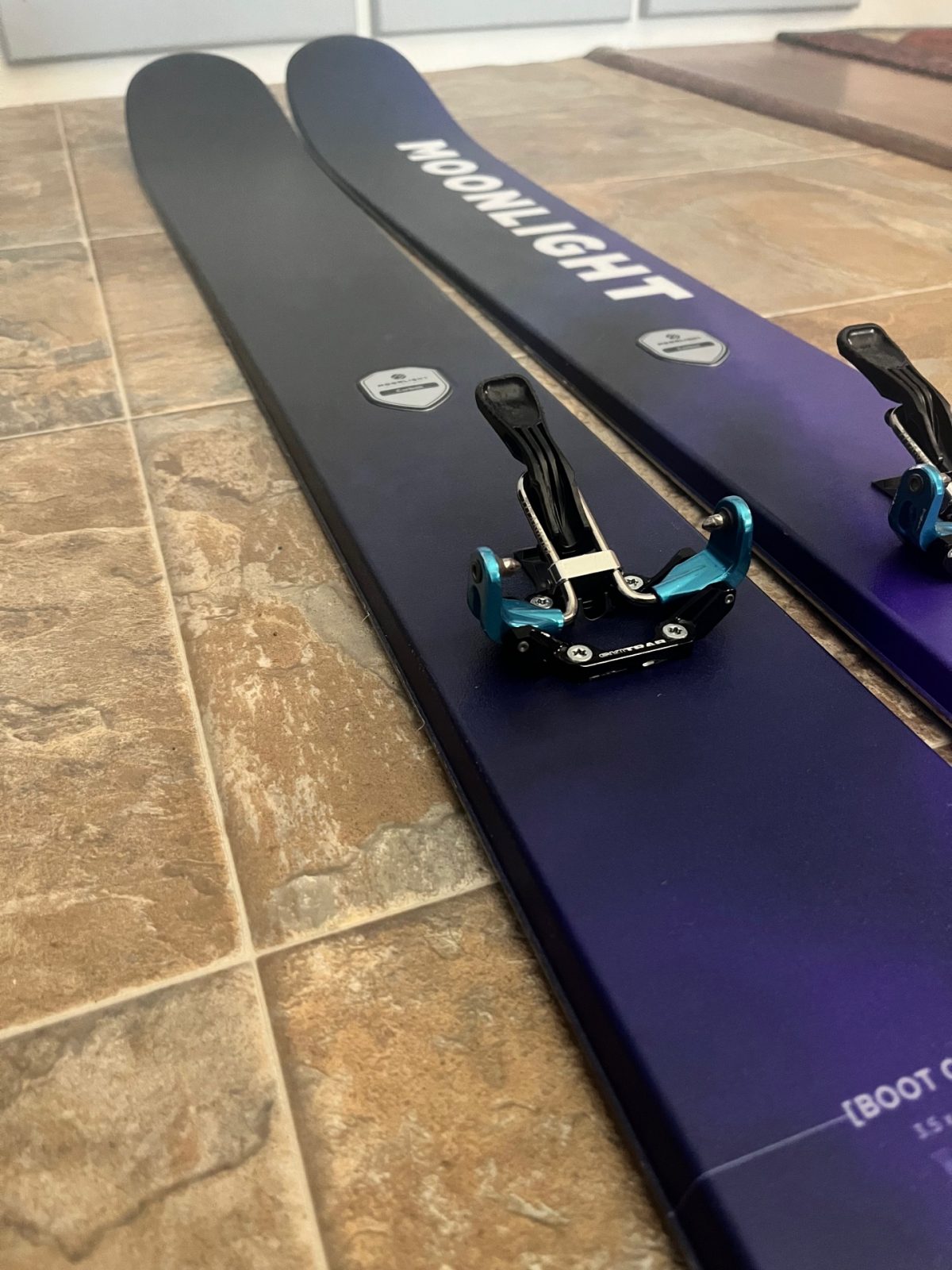
The ski’s claimed weight is 1625g in the 50/50 build. The skis were mounted with a Ski Trab Gara Titan.
Cruiser 120 Design Highlights
From the moment I picked up the ski box from my front porch, the light weight of the Cruiser was awesome. Aside from the weight, everything about these skis is subtle. The ‘Northern Lights’ graphics are simple but a beautiful homage to the skis’ Arctic origins. The rocker, sidecut, and taper are also quite subtle, with some resemblance to the old DPS Lotus 120 hybrid and less in common with some of the more radical powder ski shapes of recent years. The tip rocker is quite subtle- 55cm long; it rises less than 1 cm before the tip curve begins.
Similarly, the tail rocker is ~35cm long and rises around 6mm before the tail kicks up at the end. Moonlight specs give the Cruiser 120 5mm of camber, but my pair has just a sliver, maybe 1mm. The Cruiser has a stated radius of 26m, with essentially zero tip taper and only a bit of tail taper (the widest point is 14cm from the tail). They certainly are not a ski that will “ski short” – you’ll feel every cm of the Cruiser, for better and worse.
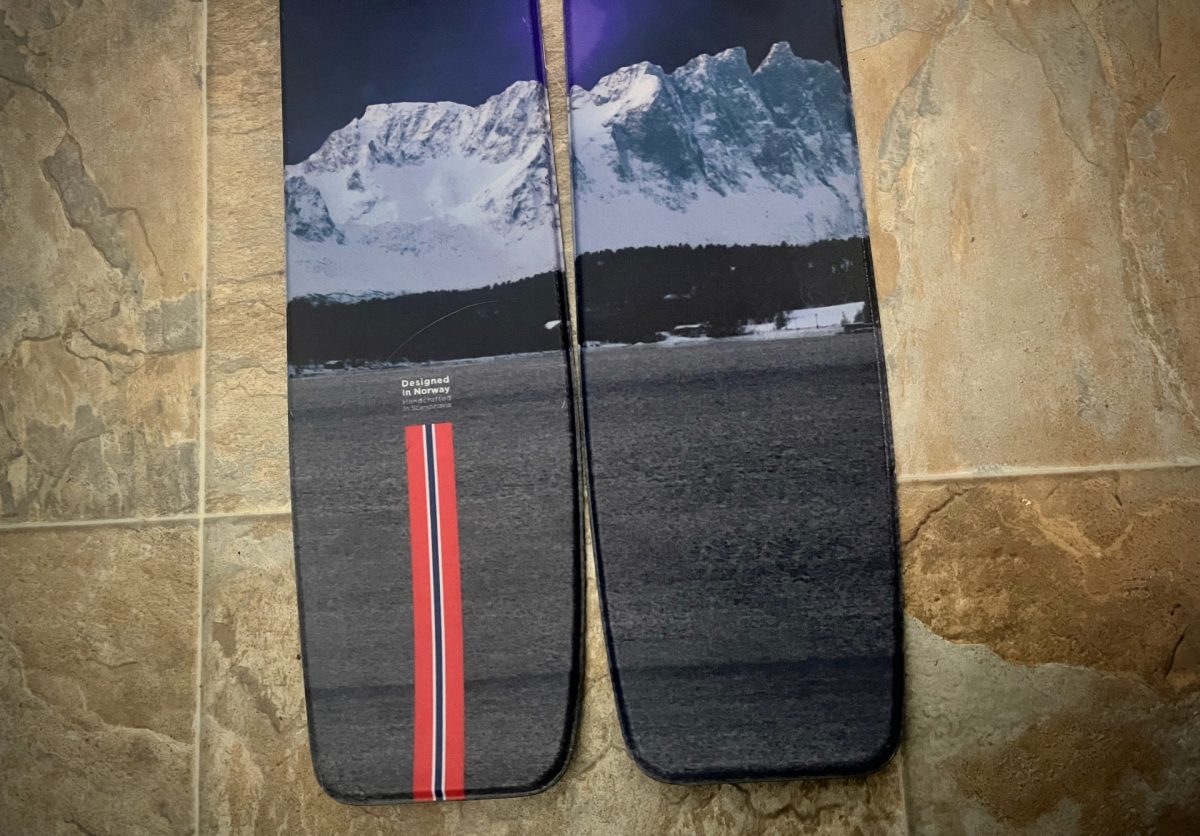
Nice tail graphics with a little fjord, some vertical relief, and a lot of Norway. For skin attachment, the 360-degree edge means no plastic tail protector to file/Dremel a notch into, but it is flat enough that a Pomoca or Contour clip stays put.
At 1625g, the construction and durability certainly come into question – is it possible to hit those specs with a durable ski? So far, the answer here is yes. The full wrap edges are middle-of-the-road thickness, not thick like a Moment or Voile, but not of immediate concern like the old paperclip edges on the Sportiva Vapor Nano. The bases seem hard and durable; I have come to battle with a few rocks and branches, with minimal ill effect on the bases. They have a factory “powder structure” as well- the verdict is out on how much this helps glide, but it does look nice.
Up top, they are a cap construction, with what Moonlight calls Fjaercore – I guess this is their secret blend of lightweight wood, carbon, and fiberglass that makes the skis so light. Unfortunately, there is no metal reinforcement in the binding area – something I would prefer to have, but not a dealbreaker on a ski that I don’t plan to push too far out of its powder skiing comfort zone. The flex is quite stiff; I would describe them as very stiff underfoot through the tail, with a slightly softer tip area. They certainly elicit thoughts of the classic, uber-stiff ultralight carbon ski.
Other design notes: The general build quality and “feel” is exceptional – there are zero perceptible imperfections in the build. For skin attachment, the 360-degree edge means no plastic tail protector to file/Dremel a notch into, but it is flat enough that a Pomoca or Contour clip stays put.
Without taper and a pretty square shape, the tip could be difficult with some skin systems. It worked great with a wide (120mm?) Pomoca loop, but I would guess the older BD wire loops, and probably the new BD style clip wouldn’t get much purchase on the big square tips here.
Moonlight offers Pomoca Free Pro 2.0 skins for purchase with the skis, which feels like an ideal pairing. I mounted on the recommended line at -11cm but would be curious if moving +1 or +2cm would make things feel a little easier going; more on that later.
Field Testing the Cruiser 120
Powder/soft snow
This is what we came for, right?!
Unlike winter 2021, 2022 didn’t deliver day after day of deep, fluffy powder like we have come to expect here in the Tetons. That said, I was able to hunt down enough powder to get a good idea of how the Cruiser performs here. Right off the bat, the Cruiser is a very different experience in deep powder than anything I’ve skied previously. It wasn’t so much that I could pressure the tips and initiate turns from the front of my boots. I had to ski this way; otherwise, the Cruiser didn’t want to turn. Once I had this figured out, it was an amazing experience to ski aggressively and from a forward stance in deep snow. It was remarkable how little speed the Cruiser required to plane up and support my forward stance – this was a real treat in low-angle meadows that, even on other wide skis like the 4FRNT Renegade, need much more speed to feel the tip plane and feel supportive.
Demanding is another way one might describe the Cruiser. It is essentially the antithesis of a DPS Wailer 112 or other short-radius, heavily rockered shapes. The Cruiser could feel like a handful for skiers used to something more easygoing and more comfortable in a more upright, weight-centered position. Maybe a more forward mount could help shift some weight forward and allow for more accessible turn initiation. The saving grace is that despite a demanding shape, the minimal weight will enable one to throw the skis around with good effect – a tactic I employed a few times when I found myself a little backseat and in a tight spot.
My maneuverability on the Cruiser is a massive improvement over the Blizzard Spurs, which also required a forward stance and solid tip pressure to turn – they were so damn heavy to the point of being downright scary in tighter spots requiring agility. The Renegades are the definitive winner in tight spots; with their reverse camber and tapered shape, they are quick to pivot and easy to dump speed. While the Cruiser loses to the Renegade on this front, they feel much more consistent in open terrain. The amount of forward pressure and tip float is remarkably consistent over a range of speeds, whereas the Renegade requires constant, subtle weight shifts to stay balanced as speed increases.
When I think of the perfect slope for the Cruiser, it’s wide open, +/-30 degrees, with copious, untracked powder – for its weight, I don’t think there is a ski that would be more fun to open it up with on this dreamy slope.
Crud/tracked/variable snow
With the drought that plagued us much of last winter, variable and tracked snow was a reality most days out. With a ski as big and light as the Cruiser, you may not be terribly surprised to hear that they got knocked around quite a bit in these conditions.
Most notably, on a midwinter day with ~6″ of fresh snow after a long drought period that left some refrozen tracks present but hard to identify below the surface, I had an often challenging time on the Cruiser. These conditions are tricky on any ski, but the combination of low weight getting deflected around and all the torque transferred to my ankles and knees from the wide skis was, at best, challenging and, at worst, felt ligament endangering.
The Cruiser fared better in snow with a consistent hardness – like powder with recent fresh tracks. They did a decent job punching through soft slough piles and tracks in a predictable manner with minimal deflection.
Firm Snow/couloirs
Yikes…
2D Snow/Corn
I’m not sure there is a great reason to break out a 120mm ski in corn, but for variety’s sake, I gave it a try a few times. The biggest issue here wasn’t so much on the way down but skinning up. Firm skin tracks combined with 120mm skis are a recipe for sore ankles and poor grip. Though not nearly as treacherous as the full rocker Renegades, I recommend ski crampons for spring outings on the Cruiser.
On the way down, the width was notably more demanding on my knees and ankles than a skinnier ski, but the Cruiser was enjoyable to make big sweeping turns and felt locked in and solid on edge in good corn snow. It was easy to break the tail free and smoothly kill a bit of speed as well – overall, despite not being ideal for corn skiing, they were enjoyable and solid.
Final Thoughts on the Cruiser 120
One can only hope that the powder gods smile on us this winter and I get to enjoy many days on the Cruiser 120s in 2023. Yet, these skis are a specialized option to fill a spot in a powder enthusiast’s quiver rather than a first backcountry ski or a one-ski quiver. I recommend the Cruiser for folks that enjoy a more traditional ski shape and style in their narrower skis, think Kaestle, Blizzard, Movement, etc., and are looking for a tool for big tours on big powder days.
Gavin is a mountain guide and gear fanatic based in Jackson, WY. His endless pursuit of gear perfection led to starting a pack company, Apocalypse Equipment in 2019. He has a degree in Nordic skiing and mechanical engineering from the University of New Hampshire and worked as a ski shop tech prior to getting his dream job as a WildSnow contributor.

